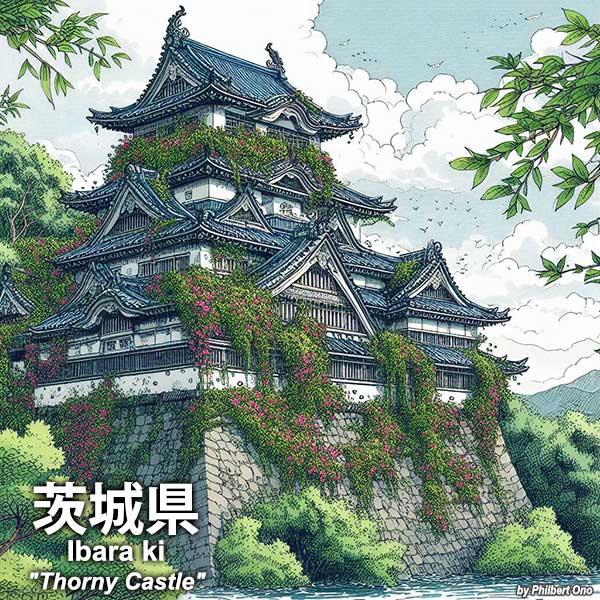IBARAKI – Thorny Castle 茨城県

The name “Ibaraki” has been around as the name of a district even before the old Hitachi Province was established in the 7th century in present-day Ibaraki Prefecture. It was previously pronounced as “Ubaraki.”
・As written in the Hitachi Province Records (常陸国風土記) from the 8th century, there are two theories (or legends) regarding the Ibaraki name’s origin:
Theory 1: An Oo Clan warrior named Kurosaka-no-Mikoto sent to Hitachi by the Imperial Court used thorns (ibara 茨) to eliminate the thieves who were natives in the area.
Theory 2: Kurosaka-no-Mikoto built a castle made of thorns (ibara) to protect people from thieves and robbers.
Both these legends stem from the ancient Yamato government (250–710 A.D.) when government figures were commonly depicted as heroes expanding the Yamato’s power.
・Another theory says that the castle might have been built in a spot with thorny bramble.
・The kanji characters could also be ateji chosen only for phonetic purposes without a significant meaning.
・According to the Wamyō Ruijushō (Dictionary of Japanese Names 和名類聚抄) from the 10th century, Ibaraki District had a hamlet named “Ibaraki.” It was probably located in present-day Ishioka city and was the provincial capital (kokufu 国府). The historic site of an ancient Buddhist temple named Ibaraki Temple (茨木寺 or 茨寺) from that era was also found in rural Ishioka in 1979 (茨城廃寺跡). Excavated pottery pieces revealed the temple’s name. Notable that it was also written as 茨木 which means “thorny tree.”
・Ibaraki District and five other districts existed even before Hitachi Province was established in the 7th century.
・There is no castle named “Ibaraki Castle.” It’s only a place name.
・After the samurai domains were abolished, Hitachi Province was split into multiple prefectures but none were named “Ibaraki.” It wasn’t until the six prefectures (Mito, Matsuoka, Shishido, Kasama, Shimodate, Shimotsuma) merged to form a new prefecture named after Ibaraki District where the prefectural capital and Mito Castle were located. “Mito Prefecture” wasn’t used because it was the name of a major samurai domain and clan (related to the ruling Tokugawa government) who didn’t do much for the new Meiji government. The prefectural capital is still named “Mito” which must be adequate consolation.
・Note that the pronunciation is “Ibaraki,” not “Ibaragi.” Commonly mispronounced even by the Japanese. Not to be confused with the city of Ibaraki in Osaka written with a different kanji character 茨木 meaning “thorny tree.”
Old province names: Hitachi-no-Kuni + Shimosa-no-Kuni (常陸国+下総国)
*The AI-generated image is for illustrative purposes only and may not accurately depict any particular place in the prefecture.
Origin of other prefectural names (etymologies)
Overview | Aichi | Akita | Aomori | Chiba | Ehime | Fukui | Fukuoka | Fukushima | Gifu | Gunma | Hiroshima | Hokkaido | Hyogo | Ibaraki | Ishikawa | Iwate | Kagawa | Kagoshima | Kanagawa | Kochi | Kumamoto | Kyoto | Mie | Miyagi | Miyazaki | Nagano | Nagasaki | Nara | Niigata | Oita | Okayama | Okinawa | Osaka | Saga | Saitama | Shiga | Shimane | Shizuoka | Tochigi | Tokushima | Tokyo | Tottori | Toyama | Wakayama | Yamagata | Yamaguchi | Yamanashi